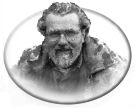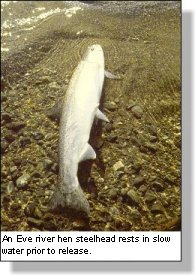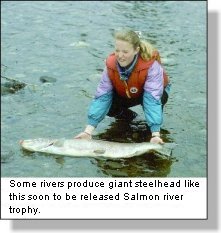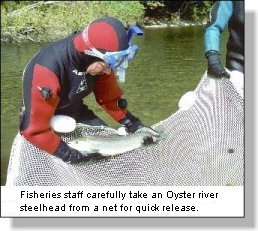
Steelhead fishing series
"British Columbia Steelhead, Extinct or Extirpated?"
with Barry M. Thornton
 The drastic need in 1998 to place angling closures on east coast Vancouver
Island streams because of the extreme low numbers of steelhead is
a major example of the serious situation facing all British Columbia
steelhead. In 1997 some east coast V.I. rivers were closed to angling
when B.C. Fisheries staff, doing annual number count swims, located
very few fish in these rivers. In fact, in some streams less than ten
fish were spotted during times when major runs of fish should have been
in the streams. Late 1997 swims provided a major wake-up call when in
some cases even fewer fish were spotted. It is definitely a time to
address the specific needs of these and other British Columbia steelhead
races.
 British
Columbia has two lists of threatened wildlife species. The first, the
"RED LIST" shows those wildlife species which "... are
candidates for legal designation as endangered or threatened."
The second list, the "BLUE LIST" shows those species which
"... are considered to be vulnerable or sensitive." British
Columbia has two lists of threatened wildlife species. The first, the
"RED LIST" shows those wildlife species which "... are
candidates for legal designation as endangered or threatened."
The second list, the "BLUE LIST" shows those species which
"... are considered to be vulnerable or sensitive."
Some of the species more commonly known on the RED LIST include; Pacific
Giant Salamander, Northern Goshawk, Sage Grouse, Spotted Owl, Vancouver
Island Marmot, Sea
Otter and Dall's Sheep. The RED LIST totals 64 separate species.
The BLUE LIST total 87 separate species. Some of those more commonly
known include the Western Rattlesnake, Great
Blue Heron, Trumpeter
Swan, Bald
Eagle, Barn Owl, Steller's Jay (British Columbia's official bird),
Wolverine,
Grizzly Bear
and Vancouver Island's Roosevelt Elk.
But, while these species are very carefully managed and in many cases
completely protected, where is the red or blue list of "endangered
or threatened," "vulnerable or sensitive" summer and
winter steelhead species? It is a known fact that almost all Vancouver
Island rivers and streams (over 300 complex watersheds) once held viable
populations of summer and winter steelhead. We also know that many V.I.
creeks once had populations of winter steelhead along with resident
and anadromous cutthroat
trout. In many cases these viable populations consisted of adult
returns of only a few hundred fish but, these were evolutionary totals
which nature considered sufficient for these stream specific races.
anadromous cutthroat
trout. In many cases these viable populations consisted of adult
returns of only a few hundred fish but, these were evolutionary totals
which nature considered sufficient for these stream specific races.
Scientists now recognize that steelhead in every watershed are unique.
They have evolved to perfectly fit those specific natural selections
of high and low water flow, geological features, aquatic food species,
and chemicals which are unique to that river. This complex
individual watershed environment has created a separate and genetically
different: Gold River steelhead, Campbell River steelhead, Puntledge
River steelhead, Stamp River steelhead, Nanaimo River steelhead, Cowichan
River steelhead, and so on, throughout every British Columbia watershed.
The beauty and survival of the English language lies in the fact that
we do have words which express precisely and completely emotions, facts
and situations. One such word is extirpated. It means, to eradicate
or to destroy wholly. In the case of British Columbia steelhead it is
my fear that there is an acceptance of individual stream steelhead
eradication for the concept exists that there is always another river
where we can find steelhead. Such is the case with British Columbia's unique river steelhead. Yes, they have been eradicated,
and, in some cases destroyed wholly. I would prefer to suggest, as have
some fisheries biologists, that we have not only destroyed some steelhead
races wholly, we have caused the actual extinction of individual unique
river species.
British Columbia's unique river steelhead. Yes, they have been eradicated,
and, in some cases destroyed wholly. I would prefer to suggest, as have
some fisheries biologists, that we have not only destroyed some steelhead
races wholly, we have caused the actual extinction of individual unique
river species.
The word extinct means, to exterminate, no longer existing. Many would
say that this is the actual state of our unique river races of steelhead;
they no longer exist! Hatchery programs have been used to add steelhead
to river systems where this extinction has occurred but, it has become
necessary to continue yearly these hatchery or 'urban' fish plantings
simply because hatchery steelhead seem unable to re-populate
these rivers on their own.
In the United States, according to Art Tautz, B.C. Fisheries Research
Director, genetically unique fish stocks are listed as a specific species
and hence can come under the protection of the U.S. Endangered Species
Act. Canada has not gone that far yet but, Tautz feels that most fisheries
scientists feel that the U.S. model is the way to go.
 The
last two decades has seen such a dramatic decrease in steelhead stocks
throughout B.C. that it is obvious that dramatic intervention is needed
to protect those few that remain. The very least should be a designation
on the B.C. endangered and threatened RED LIST. The more rational and
comprehensive change should be a recognition that every river's steelhead
races, summer and winter, must be considered unique and The
last two decades has seen such a dramatic decrease in steelhead stocks
throughout B.C. that it is obvious that dramatic intervention is needed
to protect those few that remain. The very least should be a designation
on the B.C. endangered and threatened RED LIST. The more rational and
comprehensive change should be a recognition that every river's steelhead
races, summer and winter, must be considered unique and
they must be managed and protected site specific to that race's watershed.
Unfortunately, B.C. steelhead have few champions, few river guardians
who are able to affect the necessary changes required to protect those
'wild' races that remain. The one organization that has championed these
fish for the past three decades, the Steelhead Society of B.C., has
done much to bring sane management to our watersheds. But, they are
but one voice in what we now know is a complex problem which reaches
as far as the
middle of the vast Pacific Ocean. Legislation to protect each race is
a necessary starting point. This can be done if we recognize that steelhead
are the barometer of healthy streams and that each watersheds individual
steelhead race is unique.
© Copyright Barry M. Thornton
Barry M. Thornton
|





 British
Columbia has two lists of threatened wildlife species. The first, the
"RED LIST" shows those wildlife species which "... are
candidates for legal designation as endangered or threatened."
The second list, the "BLUE LIST" shows those species which
"... are considered to be vulnerable or sensitive."
British
Columbia has two lists of threatened wildlife species. The first, the
"RED LIST" shows those wildlife species which "... are
candidates for legal designation as endangered or threatened."
The second list, the "BLUE LIST" shows those species which
"... are considered to be vulnerable or sensitive." anadromous
anadromous  British Columbia's unique river steelhead. Yes, they have been eradicated,
and, in some cases destroyed wholly. I would prefer to suggest, as have
some fisheries biologists, that we have not only destroyed some steelhead
races wholly, we have caused the actual extinction of individual unique
river species.
British Columbia's unique river steelhead. Yes, they have been eradicated,
and, in some cases destroyed wholly. I would prefer to suggest, as have
some fisheries biologists, that we have not only destroyed some steelhead
races wholly, we have caused the actual extinction of individual unique
river species. The
last two decades has seen such a dramatic decrease in steelhead stocks
throughout B.C. that it is obvious that dramatic intervention is needed
to protect those few that remain. The very least should be a designation
on the B.C. endangered and threatened RED LIST. The more rational and
comprehensive change should be a recognition that every river's steelhead
races, summer and winter, must be considered unique and
The
last two decades has seen such a dramatic decrease in steelhead stocks
throughout B.C. that it is obvious that dramatic intervention is needed
to protect those few that remain. The very least should be a designation
on the B.C. endangered and threatened RED LIST. The more rational and
comprehensive change should be a recognition that every river's steelhead
races, summer and winter, must be considered unique and